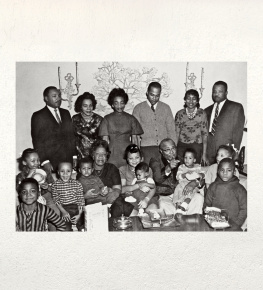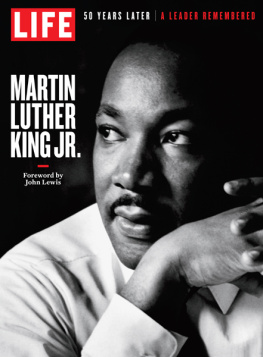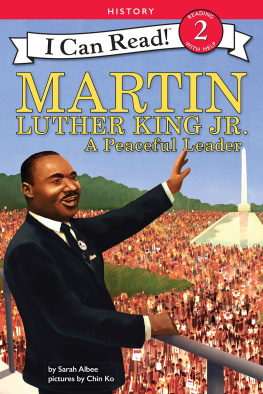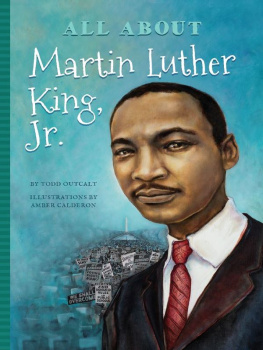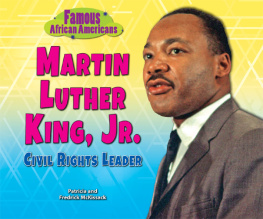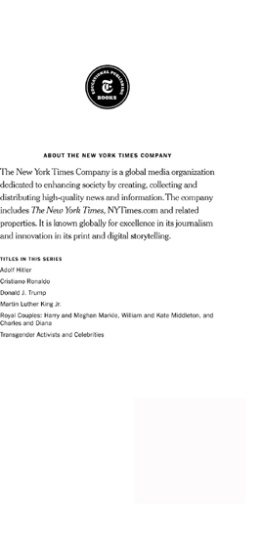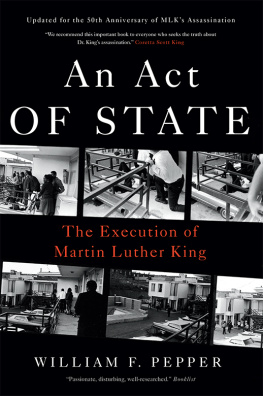

Editor: Howard Reeves
Designer: Rogers Eckersly Design
Production Manager: Alison Gervais
Library of Congress Cataloging-in-Publication Data:
Watkins, Angela Farris.
Martin Luther King Jr. : a King family tribute / edited by Angela Farris Watkins.
p. cm.
Includes bibliographical references and index.
ISBN 978-1-4197-0269-3 (alk. paper)
eISBN 978-1-68335-742-1
1. King, Martin Luther, Jr., 1899-1984. 2. King, Martin Luther, Jr., 19291968Family. 3. African American civil rights workersBiography. 4. African American leadershipHistory20th century. 5. African AmericansCivil rightsHistory20th century. 6. Civil rights MovementsUnited StatesHistory20th century. I. Title.
E185.97.K5W325 2012
323.092dc23
[B]
2012008320
Compilation copyright 2012 Angela Farris Watkins
For individual essay credits and photo credits see .
Note: Many of the photographs reproduced in this book are in pristine condition, while others are torn and frayed, even copies of copies of originals long lost to griefs. Further, casual photographs taken in the first part of the twentieth century have not held up well to the test of time. But all the photographs in this book are treasured keepsakes of the King family, shared with us as a whole for the first time.
Published in 2012 by Abrams, an imprint of ABRAMS. All rights reserved. No portion of this book may be reproduced, stored in a retrieval system, or transmitted in any form or by any means, mechanical, electronic, photocopying, recording, or otherwise, without written permission from the publisher.
Abrams books are available at special discounts when purchased in quantity for premiums and promotions as well as fundraising or educational use. Special editions can also be created to specification. For details, contact specialsales@abramsbooks.com or the address below.

ABRAMS The Art of Books
195 Broadway, New York, NY 10007
abramsbooks.com
To the generations of Kings; now living, before, and evermore.
With gratitude to Almighty God. May faith, hope, and love abide!

Martin Jr. and his sister Christine in 1930.
FOREWORD
Martin Luther King Jr. was a global phenomenon. He dreamed a new world but also spent twenty of his thirty-nine years making it a reality for citizens from the American South, as well as for those around the world.
The monument for Martin Luther King Jr. on the National Mall in Washington, DC, is a testament to his life and vision. But what causes such greatness? How do some men emerge and tower over history while most of us become merely victims of our life circumstances?
It is important to have some understanding and insight into the childhood and youth of this monumental personality. No one can better supply those insights than members of his own family.
Of course, family members are prone to point out those special signs of genius and prophecy, and theres no doubt there were many, now that we are looking back. But who was ML the boy? The boy who went to day camp at the Butler Street YMCA, worked in a mattress factory, picked tobacco with other Morehouse students in Connecticut.
Who was the boy of fifteen entering Morehouse College? What did Dr. Benjamin Mays see in him that other professors did not? What kind of son, brother, husband, father, pastor, was he?
I was amazed the first time I saw him on a basketball court or by a pool table speaking nonviolence in Birmingham. He spoke to everyone, always having time for the least of those Gods children. Where did these manhood skills come from?
Included here is a special family tribute by Dr. Christine King Farris, the sister of Dr. King and the only surviving member of his childhood home. Only his family can give us the clues to his calling; the boy, the youth, the student, and finally the man among men and the man of God.
Thanks to his family for taking on this challenge.
ANDREW YOUNG

In these pages you will experience
the love and the struggle that surrounded
Dr. Martin Luther King Jr.
as he developed into a leader of a movement
committed to a just society for all people.
The personal reflections of family and friends
featured here attest to the power of peace and
harmony that he expressed.

INTRODUCTION
Although King of Hearts is a phrase strongly marked all over the world and is particularly powerful in the hand of the player to whom that card is dealt, King of Heart denotes the power that one man had to ignite significant changes in America and inspire generations of world citizens. His last name was KingMartin Luther King Jr.and he, with heart, led the American Civil Rights movement.
This is a tribute to his life and work composed of the personal reflections of his family and a few close friends. These reflections bear witness to Martin Luther King Jr.s unshakeable commitment to justice, righteousness, and truth. They highlight his powerful example of love.
Born on January 15, 1929, Martin Luther King Jr. entered a household of freedom fighters and a community of change agents. It was no accident that he became a change agent and freedom fighter for the world. The home into which he was born was headed by those who knew injustice firsthand and who armed themselves with courage, faith in God, and a determination to do something about it.
Martin Luther King Jr.s maternal great-grandparents, Willie and Lucretia Williams, were former slaves, who lived in Greene County, Georgia. They were the parents of thirteen children, among them a set of twins, Adam Daniel and his sister Eve.
Adam Daniel Williams, grandfather of Martin Luther King Jr., was armed with a covenant relationship with God and forged the idea of a family committed to justice. Martin Luther King Sr., his father, shared that goal. Martin Luther King Jr. grew up in a household with his maternal grandfather, his maternal grandmother, his father, his mother, his aunt Ida (the sister of his maternal grandmother), and his two siblings, so he learned many lessons from them. He saw injustice first hand and developed the same determination and courage that he observed in his father and grandfather as they confronted injustice. Along with these lessons, his mother and grandmother nurtured him in matters of the heart, the importance of believing in himself and not exchanging hatred for justice.
Adam Daniel Williams left Greene County for Atlanta, where he made the crossing into education as a vehicle for advancement and for achieving his dreams of a better life. He graduated from Atlanta Baptist College in 1898 (it was later rechartered as Morehouse College). With an eye toward improving the lives of other African Americans, he became the second pastor in the history of Ebenezer Baptist Church and proved to be a civil rights advocate for his community. He was the founder of the Atlanta Chapter of the National Association for the Advancement of Colored People and helped to lead the effort that resulted in the opening of Atlantas first high school for African Americans (Booker T. Washington High School), later attended by his grandson, Martin Luther King Jr.
Next page
